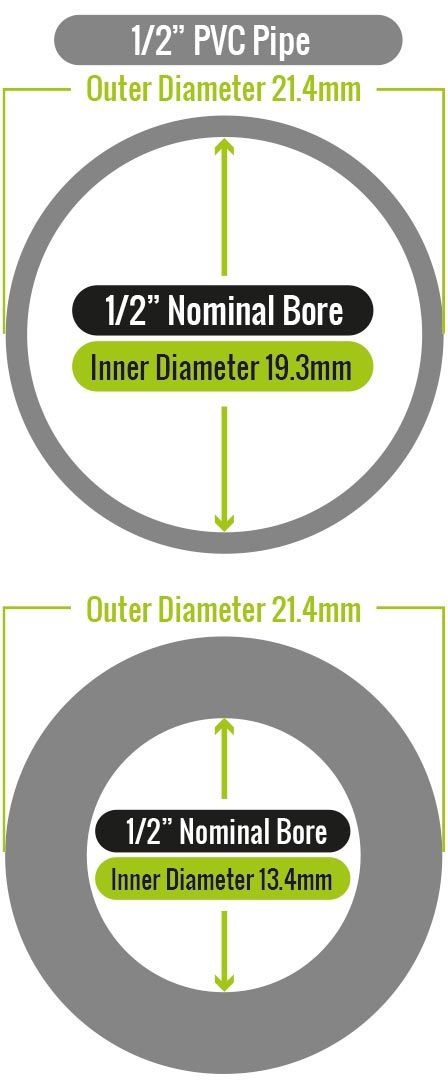In this article:
We explain the Measuring and referencing
methods of Imperial Pipe vs Metric Pipe
We answer: Why does Inch pipe not measure exactly what it says?
Are metric & imperial pipe interchangeable?
Whenever a pipe joint is being made, a fitting will always go over the pipe; so it is the outer diameter of the pipe & inner diameter of the fitting that are important for compatibility. Metric pipe is referenced by the outer diameter and metric fittings are referenced by the outer diameter of the pipe that it is intended to fit; so a 25mm fitting is designed to be used with a 25mm pipe. Likewise a 1" fitting is designed to be used with 1" pipe; however, imperial pipe and fittings are NOT referenced by the outer diameter, hence a 1" pipe does NOT have the outer diameter of 25.4mm, but actually 33.6mm. Therefore a 1" fitting will not fit a 25mm metric pipe. Imperial and Metric are different systems and in general not interchangeable but can be connected using adaptors.
This article attempts to explain a little more and we've created a full explanatory video that covers this subject too.
BS INCH

When specifying imperial pipe and other components for imperial pipe systems reference is made to the nominal bore (NB). For this reason, there is confusion with comparing metric and imperial pipe diameters as they are measured and referenced completely differently.
In the example above it demonstrates that as the wall thickness of the pipe changes with different pressure ratings, the inner diameter also changes, but the name does not. If you think of the word nominal as meaning “in name only”, because regardless of wall thickness or inner diameter all 1/2” pipe has to fit 1/2” fittings, it is more just a name to ensure compatibility. Unless you are very familiar with imperial pipe & fittings, it is always best to
check the actual dimensions.
METRIC
Metric pipe is specified by reference to the outer diameter or O/D.
So when you see 20mm pipe, it is referring to the outer diameter of the pipe.. easy peasy.
In the example above, it demonstrates that the wall thickness changes with different classes of pipe to accomodate elevated pressure but the O/D remains the same for compatibility.
All fittings go over the pipe, so the inner diameter of fittings designed to accept 20mm pipe will be fractionally larger than the O/D of the pipe, but still referred to as 20mm.
Our reference charts can help with identifying the correct pipe that you need and for making useful comparisons with BS Inch pipe.
In general metric and imperial pipe & fittings are not interchangeable. As demonstrated in the diagrams and chart, there is a 1.4 mm difference between the O/D of the 20mm Metric and the O/D of the 1/2" pipe, which are close equivalents from the two systems. This means that the 20mm pipe would rattle around in a 1/2" fitting, to avoid leaks and pressure losses you need a good close fit, so this would not suffice. You can convert from one system to another using a converter or adaptor, which is why our size comparison chart is useful.
CHART SHOWING THE ACTUAL OUTSIDE DIAMETER OF IMPERIAL AND METRIC PIPE AND THE CLOSEST EQUIVALENTS BETWEEN THE TWO SYSTEMS

We have prepared a video explanation to help you further understand the difference between metric and imperial pressure pipe sizes if you are still unsure. Don't forget to Like the video and Subscribe to the PipeWarehouseUK channel for more videos.
Summary:
• Imperial & Metric pipe are measured & referenced differently so aren’t easily compared.
• Nominal bore means “in name only” and isn’t an accurate reflection of the inner diameter.
• If trying to identify existing pipe, use the Outer Diameter (O/D) and a reference chart.
• Check your measurements using a Pipe Warehouse UK reference chart or give us a quick call.
It is also worth noting that all pipe is produced within tolerances and inner diameters may be vary slightly, usually within fractions of millimetres.
Our charts for this reason will show any varying dimensions as "average" alongside the tolerance range.





